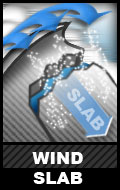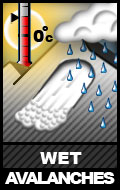Weekend Avalanche Outlook
Heightened avalanche conditions on specific terrain features. Evaluate snow and terrain carefully; identify features of concern. Natural avalanches unlikely; human-triggered avalanches possible. Small avalanches in specific areas; or large avalanches in isolated areas.
Avalanche problems:
 Stubborn to touchy human-triggered wind slab avalanches up to D2 in size are possible on leeward (primarily SW to N aspects) terrain above 2500′ that’s steeper than 35 degrees. Be on the lookout for wind slabs near peaks, along ridges, and along cross-loaded sidewalls. Cornice formation, sastrugi, hollow sounding-feeling snow, collapsing or “whumphing,” and shooting cracks will help you identify potential wind slab problems. Pole probing, digging handpits, assessing small “test slopes,” and ski cuts are effective means of understanding and managing wind slab problems.
Stubborn to touchy human-triggered wind slab avalanches up to D2 in size are possible on leeward (primarily SW to N aspects) terrain above 2500′ that’s steeper than 35 degrees. Be on the lookout for wind slabs near peaks, along ridges, and along cross-loaded sidewalls. Cornice formation, sastrugi, hollow sounding-feeling snow, collapsing or “whumphing,” and shooting cracks will help you identify potential wind slab problems. Pole probing, digging handpits, assessing small “test slopes,” and ski cuts are effective means of understanding and managing wind slab problems.

Unreactive to stubborn human-triggered persistent slab avalanches up to D3 in size are possible above 2500′, primarily on typically leeward (SW to N aspects) terrain steeper than 35 degrees. Problematic persistent slabs are most likely to be triggered on steep upper elevation terrain from a “sweet spot” where the stress from a human trigger activates a buried weak layer producing a low probability, but high consequence, hard slab avalanche. Such “sweet spots” may include convex rollovers or thin and weak areas of the snowpack where rocks and/or vegetation are exposed or closer to the surface. In order to better understand potential persistent slab problems, you’ll need to dig an actual snowpit, look at the layers, and conduct a formal stability tests (e.g. ECT).
![]()
Cornices have grown large from recent snow and strong winds. In many areas they’re large and overhanging. Stay back a safe distance from cornices, and remember that they may break off farther back than expected. Besides the inherent risk of cornice fall, a cornice fall might trigger a subsequent avalanche.

If the temperatures rise to above freezing in the alpine or there’s intense solar radiation, it will be important to watch for wet avalanches – especially wet loose avalanches (aka point releases or sluffs). While wet loose avalanches are expected to be inherently small, they may entrain enough snow to cause serious damage and may be especially problematic if exposed to terrain traps. Watch for natural wet loose avalanches coming form steep, rocky terrain that receives considerable solar radiation
